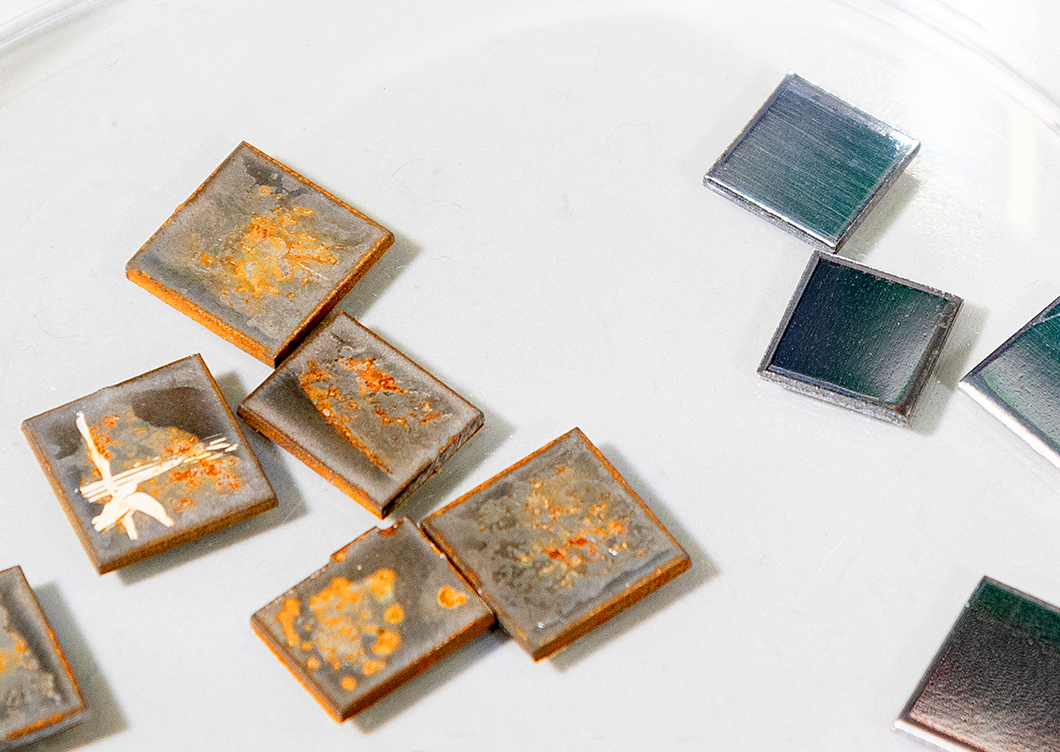
Corrosion caused by microorganisms is a worldwide problem. At BAM, microbially influenced corrosion is a research focus. The picture shows metal samples that have been exposed to a medium containing microbes. The samples show clear traces of corrosion.
Source: BAM
Corrosion by microorganisms is a worldwide problem and all kinds of material can be affected: steel, glass, plastics and even concrete. Andrea Koerdt coordinates a European research network that applies an interdisciplinary approach to develop appropriate counterstrategies.
Microbes are single-celled organisms that cannot be seen with the naked eye. Many millions of different species exist. They colonise all kinds of surfaces, sometimes attacking them directly or producing chemical substances through their metabolism that can be harmful to the substrate. Microbiologically Influenced Corrosion, or MIC for short, has thus become a threat to critical infrastructure and energy supply facilities: bridges, port facilities, motorways, electricity pylons, wind turbines, pipelines or turbines. Federal Association for Corrosion Protection estimates the annual damage at 30 billion euros in Germany alone. Effective protection methods against MIC are not yet known.
Climate change promotes MIC
So far, MIC has only been researched sporadically in Europe. There is a lack of exchange between industry and academia. There is also often a lack of an interdisciplinary approach – which would, however, make sense in view of the breadth of the materials and areas affected. In addition, experts assume that global climate change will further encourage the MIC phenomenon. Global warming accelerates the metabolism of the adaptable microbes with the result that the life span of materials can be significantly reduced. Effective counterstrategies are therefore all the more urgently needed.
At BAM, which conducts research into the safety of materials, MIC has long been a focus area. BAM is more broadly positioned in this field than almost any other institute in Europe. Scientists from around 15 disciplines work together across the boundaries of their research areas.
The microbiologist Andrea Koerdt, who coordinates research on MIC at BAM, now extends this interdisciplinary approach to the international level. She founded the Euro-MIC network in 2021 together with Torben Lund Skovhus of VIA University College in Aarhus, Denmark. “With Euro-MIC, we want to create an interdisciplinary and collaborative network, especially for young researchers,” says Andrea Koerdt. “By improving exchange between academia and industry, we hope to develop effective preventive methods against MIC.”

Andrea Koerdt in the laboratory. She deliberately exposes metal samples to a medium with microbes in order to decipher the mechanisms of the single-celled organisms.
Source: BAM
Euro-MIC is supported by the European funding organisation Cooperation in Science and Technology (COST). COST promotes international networks and thus aims to promote innovation in research.
100 institutions from 40 countries
Almost 100 institutions from 40 countries are involved in Euro-MIC, from Norway to Greece and from Portugal to Cyprus. In addition to the 38 COST member states, countries such as Australia, Japan, Canada and the United States are also represented, making Euro-MIC really more of a global network.
The members first want to develop a common terminology to facilitate understanding across disciplinary boundaries. Other goals are to research diagnostic methods, monitor MIC and search for effective counterstrategies. Online courses, workshops, summer schools, conferences and citizen science projects are being planned. “Euro-MIC addresses a worldwide problem through internationalisation and networking because major challenges in today’s science can only be solved by collaboration and interdisciplinary exchange,” says Andrea Koerdt.


